Low-Cost Room-Temperature Perovskite Solar Cells Suitable for Continuous Production
Abstract
:1. Introduction
2. Room-Temperature PSCs
2.1. Antisolvent Engineering for RT-PSCs
2.2. Vapor-Assisted for RT-PSCs
2.3. Novel Solvent for RT-PSCs
3. Full Room-Temperature PSCs
4. Summary and Outlook
Author Contributions
Funding
Conflicts of Interest
References
- McMeekin, D.P.; Sadoughi, G.; Rehman, W.; Eperon, G.E.; Saliba, M.; Hoerantner, M.T.; Haghighirad, A.; Sakai, N.; Korte, L.; Rech, B.; et al. A mixed-cation lead mixed-halide perovskite absorber for tandem solar cells. Science 2016, 351, 151–155. [Google Scholar] [CrossRef] [PubMed]
- Green, M.A.; Ho-Baillie, A.; Snaith, H.J. The emergence of perovskite solar cells. Nat. Photonics 2014, 8, 506–514. [Google Scholar] [CrossRef]
- Dong, Q.; Fang, Y.; Shao, Y.; Mulligan, P.; Qiu, J.; Cao, L.; Huang, J. Electron-hole diffusion lengths > 175 μm in solution-grown CH3NH3PbI3 single crystals. Science 2015, 347, 967–970. [Google Scholar] [CrossRef] [PubMed]
- Stranks, S.D.; Eperon, G.E.; Grancini, G.; Menelaou, C.; Alcocer, M.J.P.; Leijtens, T.; Herz, L.M.; Petrozza, A.; Snaith, H.J. Electron-hole diffusion lengths exceeding 1 micrometer in an organometal trihalide perovskite absorber. Science 2013, 342, 341–344. [Google Scholar] [CrossRef]
- Lin, Q.; Armin, A.; Nagiri, R.C.R.; Burn, P.L.; Meredith, P. Electro-optics of perovskite solar cells. Nat. Photonics 2014, 9, 106–112. [Google Scholar] [CrossRef]
- D’Innocenzo, V.; Grancini, G.; Alcocer, M.J.; Kandada, A.R.; Stranks, S.D.; Lee, M.M.; Lanzani, G.; Snaith, H.J.; Petrozza, A. Excitons versus free charges in organo-lead tri-halide perovskites. Nat. Commun. 2014, 5, 3586. [Google Scholar] [CrossRef]
- Yang, L.; Zhou, H.; Duan, Y.; Wu, M.; He, K.; Li, Y.; Xu, D.; Zou, H.; Yang, S.; Fang, Z.; et al. 25.24%-Efficiency FACsPbI3 perovskite solar cells enabled by intermolecular esterification reaction of DL-carnitine hydrochloride. Adv. Mater. 2023, 35, e2211545. [Google Scholar] [CrossRef]
- Park, J.; Kim, J.; Yun, H.S.; Paik, M.J.; Noh, E.; Mun, H.J.; Kim, M.G.; Shin, T.J.; Seok, S.I. Controlled growth of perovskite layers with volatile alkylammonium chlorides. Nature 2023, 616, 724–730. [Google Scholar] [CrossRef]
- Kim, H.S.; Lee, C.R.; Im, J.H.; Lee, K.B.; Moehl, T.; Marchioro, A.; Moon, S.J.; Humphry-Baker, R.; Yum, J.H.; Moser, J.E.; et al. Lead iodide perovskite sensitized all-solid-state submicron thin film mesoscopic solar cell with efficiency exceeding 9%. Sci. Rep. 2012, 2, 591. [Google Scholar] [CrossRef]
- Kojima, A.; Teshima, K.; Shirai, Y.; Miyasaka, T. Organometal halide perovskites as visible-light sensitizers for photovoltaic cells. J. Am. Chem. Soc. 2009, 131, 6050–6051. [Google Scholar] [CrossRef]
- NREL Module Efficiency Chart. Available online: https://www.nrel.gov/pv/module-efficiency.html (accessed on 10 September 2023).
- Feng, S.-P.; Cheng, Y.; Yip, H.-L.; Zhong, Y.; Fong, P.W.K.; Li, G.; Ng, A.; Chen, C.; Castriotta, L.A.; Matteocci, F.; et al. Roadmap on commercialization of metal halide perovskite photovoltaics. J. Phys. Mater. 2023, 6, 032501. [Google Scholar] [CrossRef]
- Rong, Y.; Hu, Y.; Mei, A.; Tan, H.; Saidaminov, M.I.; Seok, S.I.; McGehee, M.D.; Sargent, E.H.; Han, H. Challenges for commercializing perovskite solar cells. Science 2018, 361, eaat8235. [Google Scholar] [CrossRef] [PubMed]
- Saki, Z.; Byranvand, M.M.; Taghavinia, N.; Kedia, M.; Saliba, M. Solution-processed perovskite thin-films: The journey from lab- to large-scale solar cells. Energy Environ. Sci. 2021, 14, 5690–5722. [Google Scholar] [CrossRef]
- Li, Z.; Klein, T.R.; Kim, D.H.; Yang, M.; Berry, J.J.; van Hest, M.F.A.M.; Zhu, K. Scalable fabrication of perovskite solar cells. Nat. Rev. Mater. 2018, 3, 18017. [Google Scholar] [CrossRef]
- Cui, J.; Yuan, H.; Li, J.; Xu, X.; Shen, Y.; Lin, H.; Wang, M. Recent progress in efficient hybrid lead halide perovskite solar cells. Sci. Technol. Adv. Mater. 2016, 16, 036004. [Google Scholar] [CrossRef]
- Zhou, H.; Chen, Q.; Yang, Y. Vapor-assisted solution process for perovskite materials and solar cells. MRS Bull. 2015, 40, 667–673. [Google Scholar] [CrossRef]
- Burschka, J.; Pellet, N.; Moon, S.J.; Humphry-Baker, R.; Gao, P.; Nazeeruddin, M.K.; Grätzel, M. Sequential deposition as a route to high-performance perovskite-sensitized solar cells. Nature 2013, 499, 316–319. [Google Scholar] [CrossRef]
- Liu, M.; Johnston, M.B.; Snaith, H.J. Efficient planar heterojunction perovskite solar cells by vapour deposition. Nature 2013, 501, 395–398. [Google Scholar] [CrossRef]
- Jeon, N.J.; Noh, J.H.; Kim, Y.C.; Yang, W.S.; Ryu, S.; Seok, S.I. Solvent engineering for high-performance inorganic-organic hybrid perovskite solar cells. Nat. Mater. 2014, 13, 897–903. [Google Scholar] [CrossRef]
- Jiang, Q.; Zhao, Y.; Zhang, X.; Yang, X.; Chen, Y.; Chu, Z.; Ye, Q.; Li, X.; Yin, Z.; You, J. Surface passivation of perovskite film for efficient solar cells. Nat. Photonics 2019, 13, 460–466. [Google Scholar] [CrossRef]
- Dunlap-Shohl, W.A.; Zhou, Y.; Padture, N.P.; Mitzi, D.B. Synthetic approaches for halide perovskite thin films. Chem. Rev. 2019, 119, 3193–3295. [Google Scholar] [CrossRef]
- Kwon, N.; Lee, J.; Ko, M.J.; Kim, Y.Y.; Seo, J. Recent progress of eco-friendly manufacturing process of efficient perovskite solar cells. Nano Converg. 2023, 10, 28. [Google Scholar] [CrossRef] [PubMed]
- Shi, P.; Ding, Y.; Ding, B.; Xing, Q.; Kodalle, T.; Sutter-Fella, C.M.; Yavuz, I.; Yao, C.; Fan, W.; Xu, J.; et al. Oriented nucleation in formamidinium perovskite for photovoltaics. Nature 2023, 620, 323–327. [Google Scholar] [CrossRef] [PubMed]
- Jung, M.; Ji, S.G.; Kim, G.; Seok, S.I. Perovskite precursor solution chemistry: From fundamentals to photovoltaic applications. Chem. Soc. Rev. 2019, 48, 2011–2038. [Google Scholar] [CrossRef]
- Abate, A.; Correa-Baena, J.-P.; Saliba, M.; Su’ait, M.S.; Bella, F. Perovskite solar cells: From the laboratory to the assembly line. Chem. Eur. J. 2018, 24, 3083–3100. [Google Scholar] [CrossRef] [PubMed]
- Fang, Y.; Tian, T.; Yang, M.; Tan, Y.; Zhong, J.-X.; Huang, Y.; Wang, X.; Tao, J.; Yang, S.; Zou, C.; et al. Tailoring precursor chemistry enabled room temperature-processed perovskite films in ambient air for efficient and stable solar cells with improved reproducibility. Adv. Funct. Mater. 2023, 33, 2303674. [Google Scholar] [CrossRef]
- Peng, B.; Kong, W.; Wang, T.; Qiao, L.; Zhang, L.; Yang, X. Room temperature crystallization and stability of halide perovskite thin films. Sci. Sin.-Phys. Mech. As. 2022, 52, 296811. [Google Scholar] [CrossRef]
- Yang, Z.; Pan, J.; Liang, Y.; Li, Q.; Xu, D. Ambient air condition for room-temperature deposition of MAPbI3 films in highly efficient solar cells. Small 2018, 14, e1802240. [Google Scholar] [CrossRef]
- Wei, X.; Zhang, M.; Liu, X.; Chen, F.; Lei, X.; Liu, H.; Meng, F.; Zeng, H.; Yang, S.; Liu, J. Semitransparent CH3NH3PbI3 films achieved by solvent engineering for annealing- and electron transport layer-free planar perovskite solar cells. Sol. RRL 2018, 2, 1700222. [Google Scholar] [CrossRef]
- Liu, D.; Yang, C.; Bates, M.; Lunt, R.R. Room temperature processing of inorganic perovskite films to enable flexible solar cells. iScience 2018, 6, 272–279. [Google Scholar] [CrossRef]
- Pan, J.; Mu, C.; Li, Q.; Li, W.; Ma, D.; Xu, D. Room-temperature, hydrochloride-assisted, one-step deposition for highly efficient and air-stable perovskite solar cells. Adv. Mater. 2016, 28, 8309–8314. [Google Scholar] [CrossRef] [PubMed]
- Chen, Y.; Zhao, Y.; Liang, Z. Non-thermal annealing fabrication of efficient planar perovskite solar cells with inclusion of NH4Cl. Chem. Mater. 2015, 27, 1448–1451. [Google Scholar] [CrossRef]
- Xiong, H.; Zabihi, F.; Wang, H.; Zhang, Q.; Eslamian, M. Grain engineering by ultrasonic substrate vibration post-treatment of wet perovskite films for annealing-free, high performance, and stable perovskite solar cells. Nanoscale 2018, 10, 8526–8535. [Google Scholar] [CrossRef] [PubMed]
- Ahmadian-Yazdi, M.-R.; Eslamian, M. Toward scale-up of perovskite solar cells: Annealing-free perovskite layer by low-cost ultrasonic substrate vibration of wet films. Mater. Today Commun. 2018, 14, 151–159. [Google Scholar] [CrossRef]
- Yang, B.; Dyck, O.; Poplawsky, J.; Keum, J.; Das, S.; Puretzky, A.; Aytug, T.; Joshi, P.C.; Rouleau, C.M.; Duscher, G.; et al. Controllable growth of perovskite films by room-temperature air exposure for efficient planar heterojunction photovoltaic cells. Angew. Chem. Int. Ed. 2015, 54, 14862–14865. [Google Scholar] [CrossRef] [PubMed]
- Zhou, Y.; Yang, M.; Wu, W.; Vasiliev, A.L.; Zhu, K.; Padture, N.P. Room-temperature crystallization of hybrid-perovskite thin films via solvent–solvent extraction for high-performance solar cells. J. Mater. Chem. A 2015, 3, 8178–8184. [Google Scholar] [CrossRef]
- Wang, B.B.; Zhang, Z.G.; Ye, S.Y.; Rao, H.X.; Bian, Z.Q.; Huang, C.H.; Li, Y.F. Room-temperature water-vapor annealing for high-performance planar perovskite solar cells. J. Mater. Chem. A 2016, 4, 17267–17273. [Google Scholar] [CrossRef]
- Fang, X.; Wu, Y.; Lu, Y.; Sun, Y.; Zhang, S.; Zhang, J.; Zhang, W.; Yuan, N.; Ding, J. Annealing-free perovskite films based on solvent engineering for efficient solar cells. J. Mater. Chem. C 2017, 5, 842–847. [Google Scholar] [CrossRef]
- Matsui, T.; Seo, J.-Y.; Saliba, M.; Zakeeruddin, S.M.; Grätzel, M. Room-temperature formation of highly crystalline multication perovskites for efficient, low-cost solar cells. Adv. Mater. 2017, 29, 1606258. [Google Scholar] [CrossRef]
- Zhang, H.; Cheng, J.; Li, D.; Lin, F.; Mao, J.; Liang, C.; Jen, A.K.; Grätzel, M.; Choy, W.C. Toward all room-temperature, solution-processed, high-performance planar perovskite solar cells: A new scheme of pyridine-promoted perovskite formation. Adv. Mater. 2017, 29, 1604695. [Google Scholar] [CrossRef]
- Liu, Q.; Zhao, Y.; Ma, Y.; Sun, X.; Ge, W.; Fang, Z.; Bai, H.; Tian, Q.; Fan, B.; Zhang, T. A mixed solvent for rapid fabrication of large-area methylammonium lead iodide layers by one-step coating at room temperature. J. Mater. Chem. A 2019, 7, 18275–18284. [Google Scholar] [CrossRef]
- Chen, Z.; Zhang, H.; Yao, F.; Tao, C.; Fang, G.; Li, G. Room temperature formation of semiconductor grade alpha-FAPbI3 films for efficient perovskite solar cells. Cell Rep. Phys. Sci. 2020, 1, 100205. [Google Scholar] [CrossRef]
- Wang, K.; Wu, C.; Hou, Y.; Yang, D.; Ye, T.; Yoon, J.; Sanghadasa, M.; Priya, S. Isothermally crystallized perovskites at room-temperature. Energy Environ. Sci. 2020, 13, 3412–3422. [Google Scholar] [CrossRef]
- Ahn, N.; Son, D.-Y.; Jang, I.-H.; Kang, S.M.; Choi, M.; Park, N.-G. Highly Reproducible Perovskite Solar Cells with Average Efficiency of 18.3% and Best Efficiency of 19.7% Fabricated via Lewis Base Adduct of Lead(II) Iodide. J. Am. Chem. Soc. 2015, 137, 8696–8699. [Google Scholar] [CrossRef] [PubMed]
- Mahon, N.S.; Korolik, O.V.; Khenkin, M.V.; Arnaoutakis, G.E.; Galagan, Y.; Soriūtė, V.; Litvinas, D.; Ščajev, P.; Katz, E.A.; Mazanik, A.V. Photoluminescence kinetics for monitoring photoinduced processes in perovskite solar cells. Sol. Energy 2020, 195, 114–120. [Google Scholar] [CrossRef]
- Zhou, Y.; Yang, M.; Game, O.S.; Wu, W.; Kwun, J.; Strauss, M.A.; Yan, Y.; Huang, J.; Zhu, K.; Padture, N.P. Manipulating crystallization of organolead mixed-halide thin films in antisolvent baths for wide-bandgap perovskite solar cells. ACS Appl. Mater. Interfaces 2016, 8, 2232–2237. [Google Scholar] [CrossRef]
- Zheng, X.J.; Chen, B.; Wu, C.C.; Priya, S. Room temperature fabrication of CH3NH3PbBr3 by anti-solvent assisted crystallization approach for perovskite solar cells with fast response and small J-V hysteresis. Nano Energy 2015, 17, 269–278. [Google Scholar] [CrossRef]
- Yin, M.S.; Xie, F.X.; Chen, H.; Yang, X.D.; Ye, F.; Bi, E.B.; Wu, Y.Z.; Cai, M.T.; Han, L.Y. Annealing-free perovskite films by instant crystallization for efficient solar cells. J. Mater. Chem. A 2016, 4, 8548–8553. [Google Scholar] [CrossRef]
- Zhu, W.; Chen, D.; Zhou, L.; Zhang, C.; Chang, J.; Lin, Z.; Zhang, J.; Hao, Y. Intermediate phase intermolecular exchange triggered defect elimination in CH3NH3PbI3 toward room-temperature fabrication of efficient perovskite solar cells. ACS Appl. Mater. Interfaces 2017, 9, 40378–40385. [Google Scholar] [CrossRef]
- Lv, X.; Dong, X.; Ye, Z.; Zhou, J.; Deng, F.; Zheng, Y.-Z.; Tao, X. Bromide induced room-temperature formation of photoactive formamidinium-based perovskite for high-efficiency, low-cost solar cells. Sol. RRL 2019, 3, 1800313. [Google Scholar] [CrossRef]
- Dubey, A.; Kantack, N.; Adhikari, N.; Reza, K.M.; Venkatesan, S.; Kumar, M.; Khatiwada, D.; Darling, S.; Qiao, Q.Q. Room temperature, air crystallized perovskite film for high performance solar cells. J. Mater. Chem. A 2016, 4, 10231–10240. [Google Scholar] [CrossRef]
- Yu, H.; Liu, X.; Xia, Y.; Dong, Q.; Zhang, K.; Wang, Z.; Zhou, Y.; Song, B.; Li, Y. Room-temperature mixed-solvent-vapor annealing for high performance perovskite solar cells. J. Mater. Chem. A 2016, 4, 321–326. [Google Scholar] [CrossRef]
- Peled, S.S.; Perez, M.; Meron, D.; Osherov, A.; Bulovic, V.; Katz, E.A.; Golan, Y. Morphology control of perovskite films: A two-step, all solution process for conversion of lead selenide into methylammonium lead iodide. Mater. Chem. Front. 2021, 5, 1410–1417. [Google Scholar] [CrossRef]
- Zhang, H.; Li, D.; Cheng, J.; Lin, F.; Mao, J.; Jen, A.K.Y.; Grätzel, M.; Choy, W.C.H. Room temperature formation of organic-inorganic lead halide perovskites: Design of nanostructured and highly reactive intermediates. J. Mater. Chem. A 2017, 5, 3599–3608. [Google Scholar] [CrossRef]
- Zhang, L.; Zuo, C.; Ding, L. Efficient MAPbI3 solar cells made via drop-coating at room temperature. J. Semicond. 2021, 42, 072201. [Google Scholar] [CrossRef]
- Wang, Z.; Zhu, X.; Feng, J.; Wang, C.; Zhang, C.; Ren, X.; Priya, S.; Liu, S.; Yang, D. Antisolvent- and annealing-free deposition for highly stable efficient perovskite solar cells via modified ZnO. Adv. Sci. 2021, 8, 2002860. [Google Scholar] [CrossRef]
- Wang, G.; Liao, L.; Chen, L.; Xu, C.; Yao, Y.; Liu, D.; Li, P.; Deng, J.; Song, Q. Perovskite solar cells fabricated under ambient air at room temperature without any post-treatment. Org. Electron. 2020, 86, 105918. [Google Scholar] [CrossRef]
- Dou, B.; Whitaker, J.B.; Bruening, K.; Moore, D.T.; Wheeler, L.M.; Ryter, J.; Breslin, N.J.; Berry, J.J.; Garner, S.M.; Barnes, F.S.; et al. Roll-to-Roll printing of perovskite solar cells. ACS Energy Lett. 2018, 3, 2558–2565. [Google Scholar] [CrossRef]
- Noel, N.K.; Habisreutinger, S.N.; Wenger, B.; Klug, M.T.; Hörantner, M.T.; Johnston, M.B.; Nicholas, R.J.; Moore, D.T.; Snaith, H.J. A low viscosity, low boiling point, clean solvent system for the rapid crystallisation of highly specular perovskite films. Energy Environ. Sci. 2017, 10, 145–152. [Google Scholar] [CrossRef]
- Chalkias, D.A.; Mourtzikou, A.; Katsagounos, G.; Kalarakis, A.N.; Stathatos, E. Development of greener and stable inkjet-printable perovskite precursor inks for all-printed annealing-free perovskite solar mini-modules manufacturing. Small Methods 2023, 7, e2300664. [Google Scholar] [CrossRef]
- Wang, J.; Yao, X.; Xiao, W.J.; Wang, S.; Xu, G.; Chen, X.Q.; Wu, S.C.; Visoly-Fisher, I.; Katz, E.A.; Li, Y.; et al. Mutual composition transformations among 2D/3D organolead halide perovskites and mechanisms behind. Sol. RRL 2018, 2, 1800125. [Google Scholar] [CrossRef]
- Kartikay, P.; Yella, A.; Mallick, S. All room-temperature-processed carbon-based flexible perovskite solar cells with TiO2 electron collection layer. Energy Technol. 2022, 10, 2200282. [Google Scholar] [CrossRef]
- Huang, W.; Zhang, R.; Xia, X.W.; Steichen, P.; Liu, N.J.; Yang, J.P.; Chu, L.; Li, X.A. Room temperature processed double electron transport layers for efficient perovskite solar cells. Nanomaterials 2021, 11, 329. [Google Scholar] [CrossRef]
- Wang, P.-C.; Govindan, V.; Chiang, C.-H.; Wu, C.-G. Room-Temperature-processed fullerene/TiO2 Nanocomposite electron transporting layer for high-efficiency rigid and flexible planar perovskite solar cells. Sol. RRL 2020, 4, 2000247. [Google Scholar] [CrossRef]
- Wang, F.; Zhang, Y.; Yang, M.; Du, J.; Yang, L.; Fan, L.; Sui, Y.; Liu, X.; Yang, J. Achieving efficient flexible perovskite solar cells with room-temperature processed tungsten oxide electron transport layer. J. Power Sources 2019, 440, 227157. [Google Scholar] [CrossRef]
- Tao, H.; Ma, Z.; Yang, G.; Wang, H.; Long, H.; Zhao, H.; Qin, P.; Fang, G. Room-temperature processed tin oxide thin film as effective hole blocking layer for planar perovskite solar cells. Appl. Surface Sci. 2018, 434, 1336–1343. [Google Scholar] [CrossRef]
- Huang, A.; Zhu, J.; Zheng, J.; Yu, Y.; Liu, Y.; Yang, S.; Bao, S.; Lei, L.; Jin, P. Room-temperature processible TiO2 electron selective layers with controllable crystallinity for high efficiency perovskite photovoltaics. Sol. Energy Mater. Sol. Cells 2017, 163, 15–22. [Google Scholar] [CrossRef]
- Deng, X.Y.; Wilkes, G.C.; Chen, A.Z.; Prasad, N.S.; Gupta, M.C.; Choi, J.J. Room-temperature processing of TiOx electron transporting layer for perovskite solar cells. J. Phys. Chem. Lett. 2017, 8, 3206–3210. [Google Scholar] [CrossRef]
- Deng, F.; Sun, X.; Lv, X.; Li, Y.; Li, S.; Zheng, Y.-Z.; Tao, X. All room-temperature processing efficient planar carbon-based perovskite solar cells. J. Power Sources 2021, 489, 229345. [Google Scholar] [CrossRef]
- Jiang, J.; Wang, S.; Jia, X.; Fang, X.; Zhang, S.; Zhang, J.; Liu, W.; Ding, J.; Yuan, N. Totally room-temperature solution-processing method for fabricating flexible perovskite solar cells using an Nb2O5-TiO2 electron transport layer. RSC. Adv. 2018, 8, 12823–12831. [Google Scholar] [CrossRef]
- Dong, H.; Pang, S.; He, F.; Yang, H.; Zhu, W.; Chen, D.; Xi, H.; Zhang, J.; Hao, Y.; Zhang, C. Annealing-free, high-performance perovskite solar cells by controlling crystallization via guanidinium cation doping. Sol. RRL 2021, 5, 2100097. [Google Scholar] [CrossRef]
- Cassella, E.J.; Spooner, E.L.K.; Smith, J.A.; Thornber, T.; O’Kane, M.E.; Oliver, R.D.J.; Catley, T.E.; Choudhary, S.; Wood, C.J.; Hammond, D.B.; et al. Binary solvent system used to fabricate fully annealing-free perovskite solar cells. Adv. Energy Mater. 2023, 13, 2203468. [Google Scholar] [CrossRef]

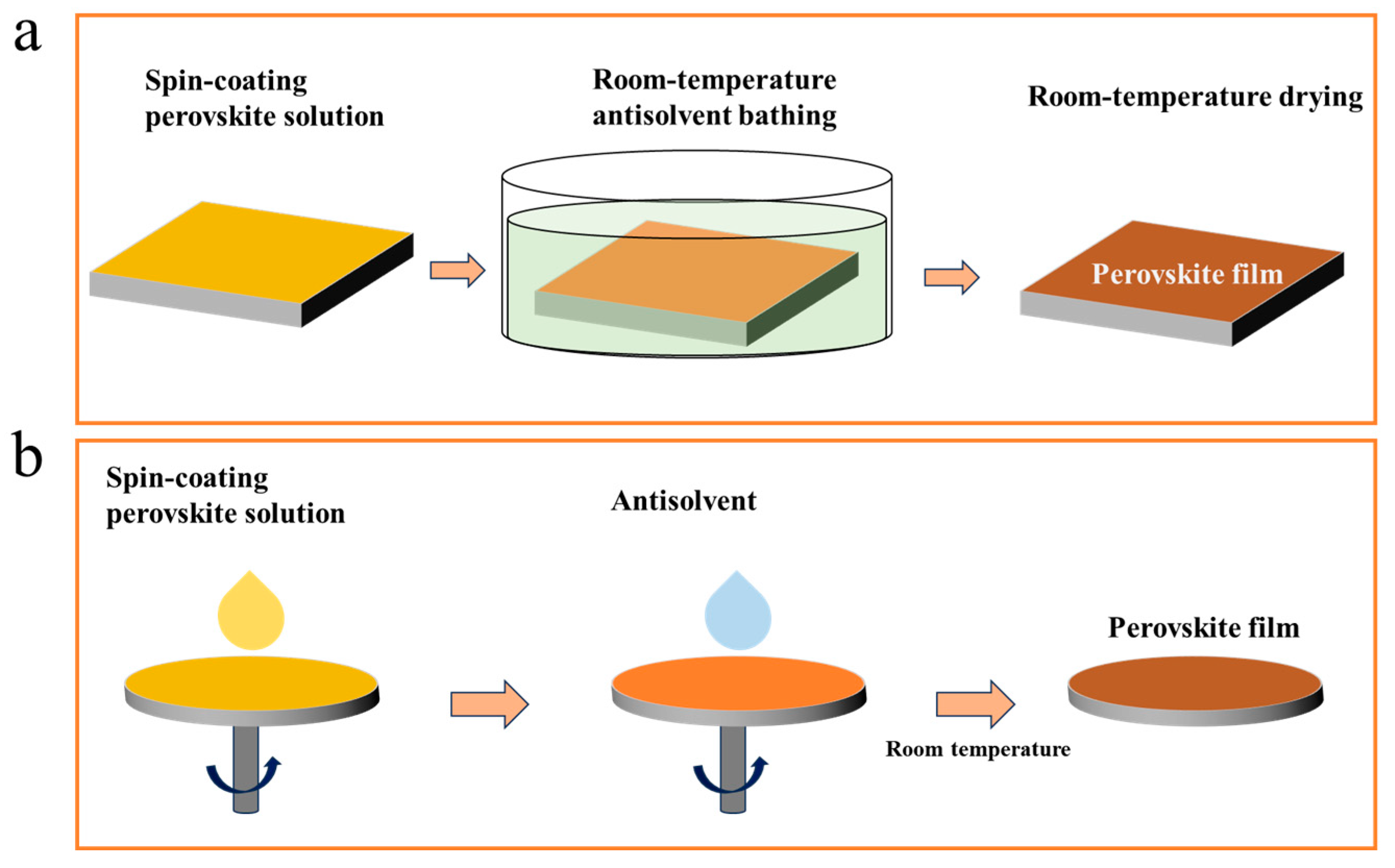
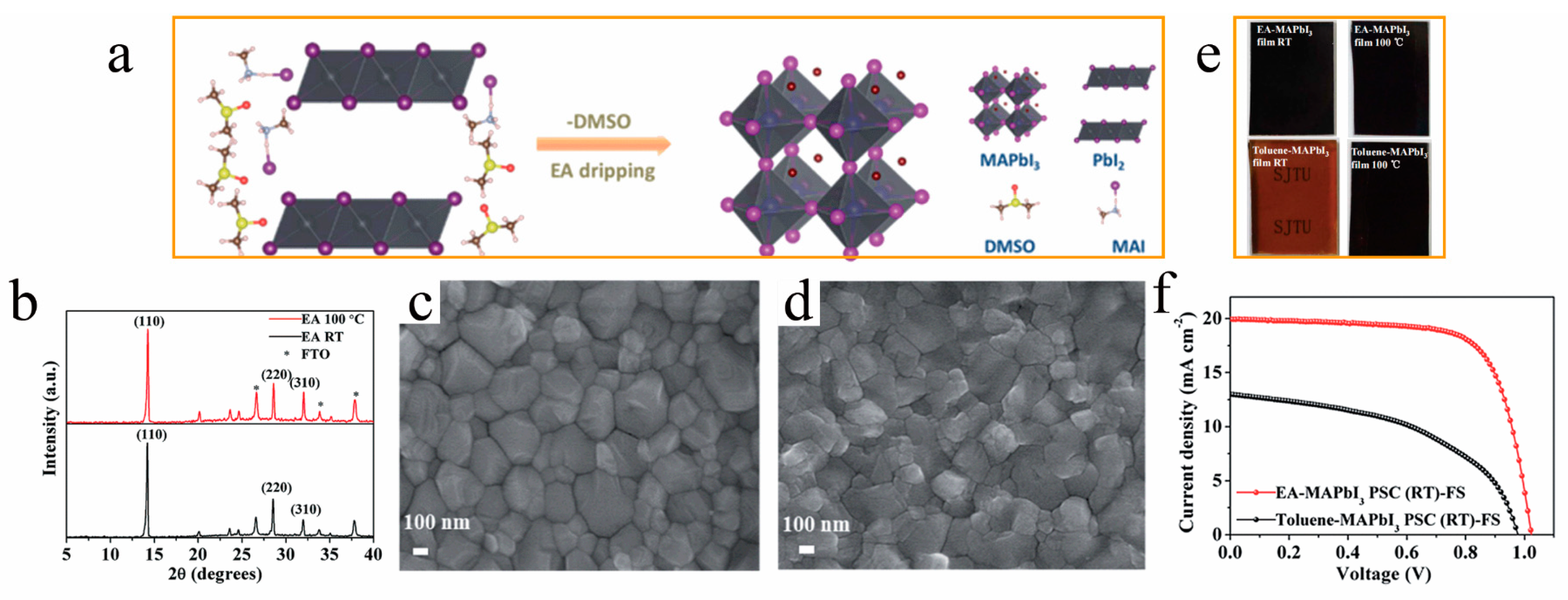
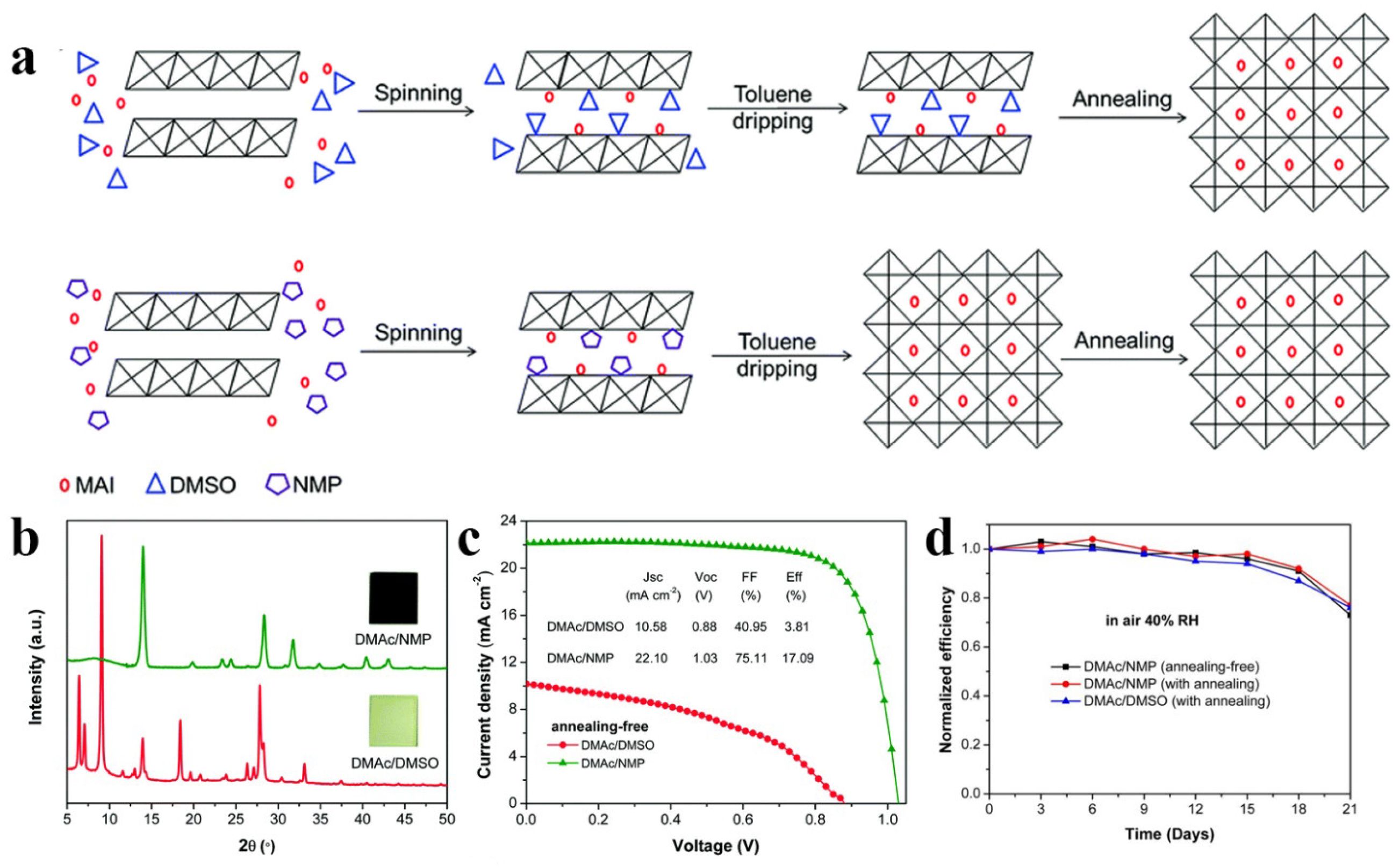
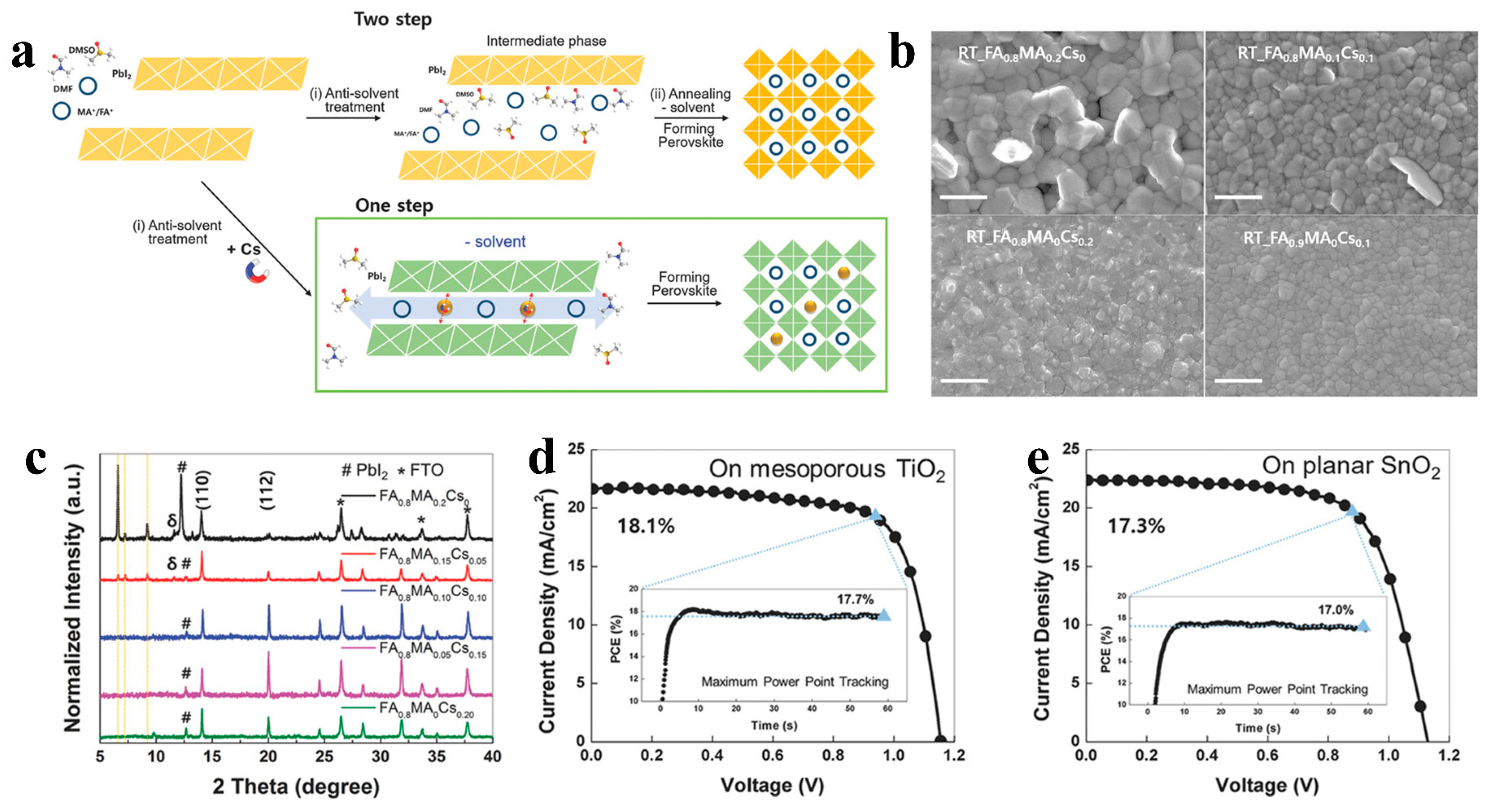


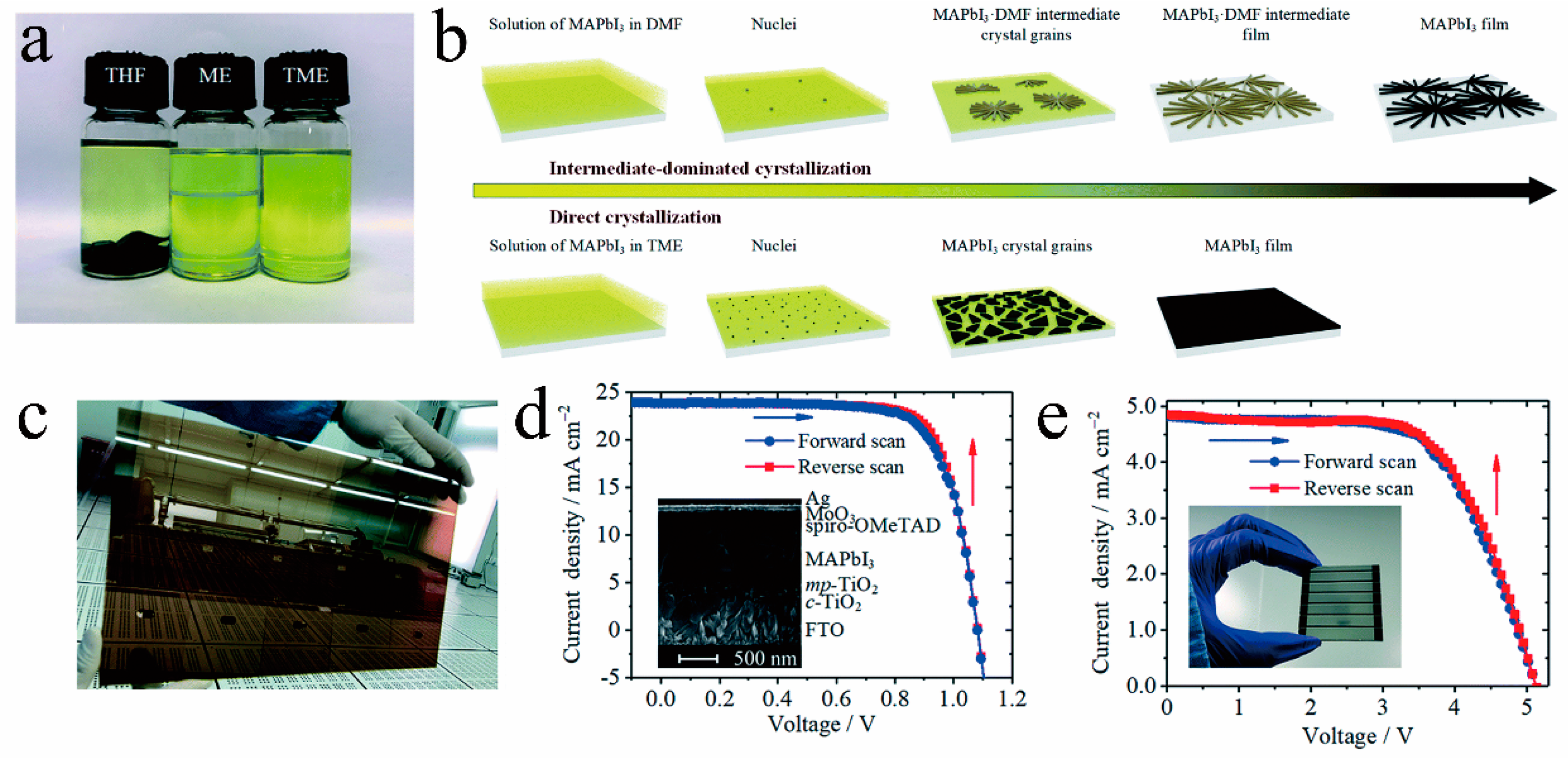
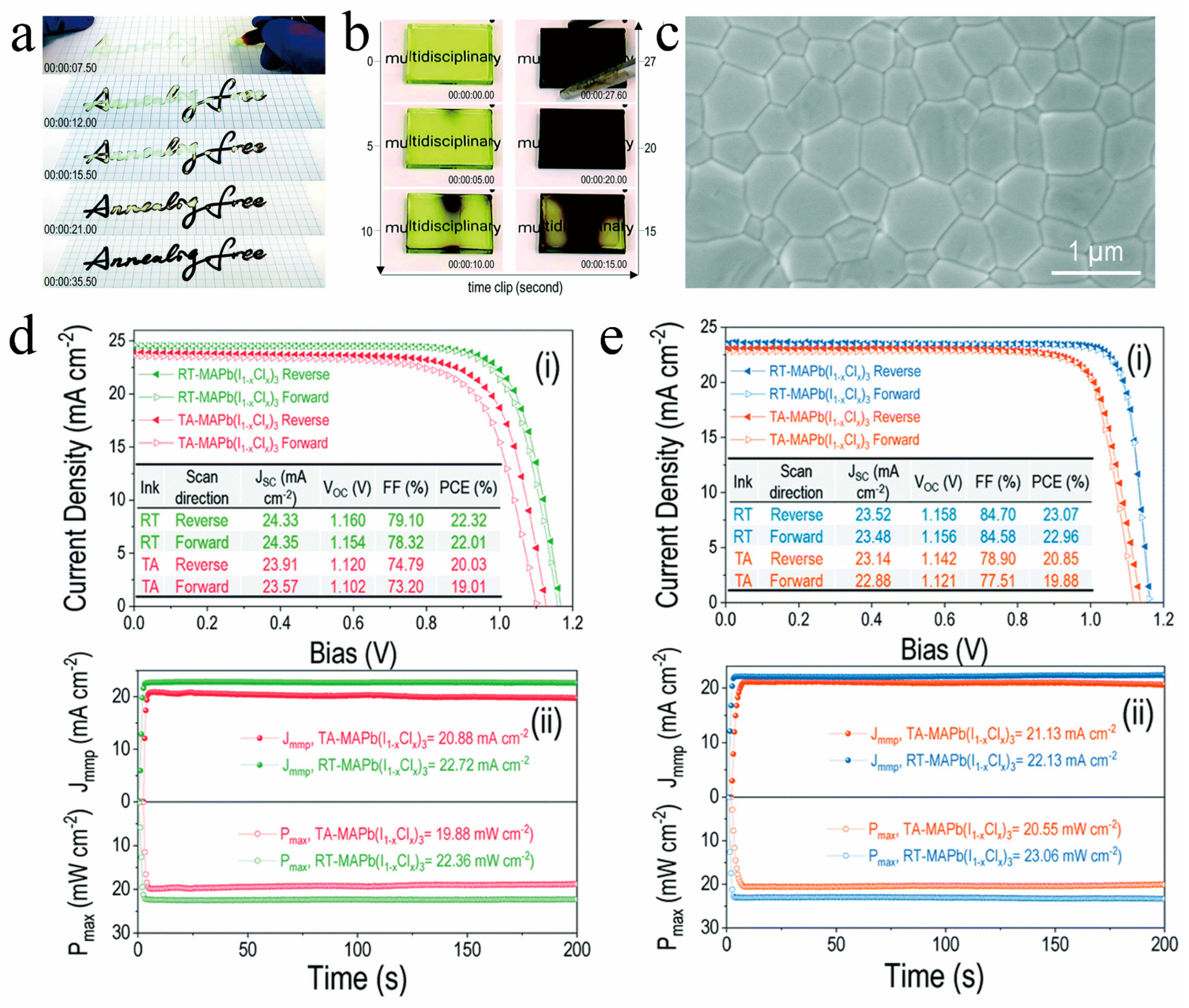
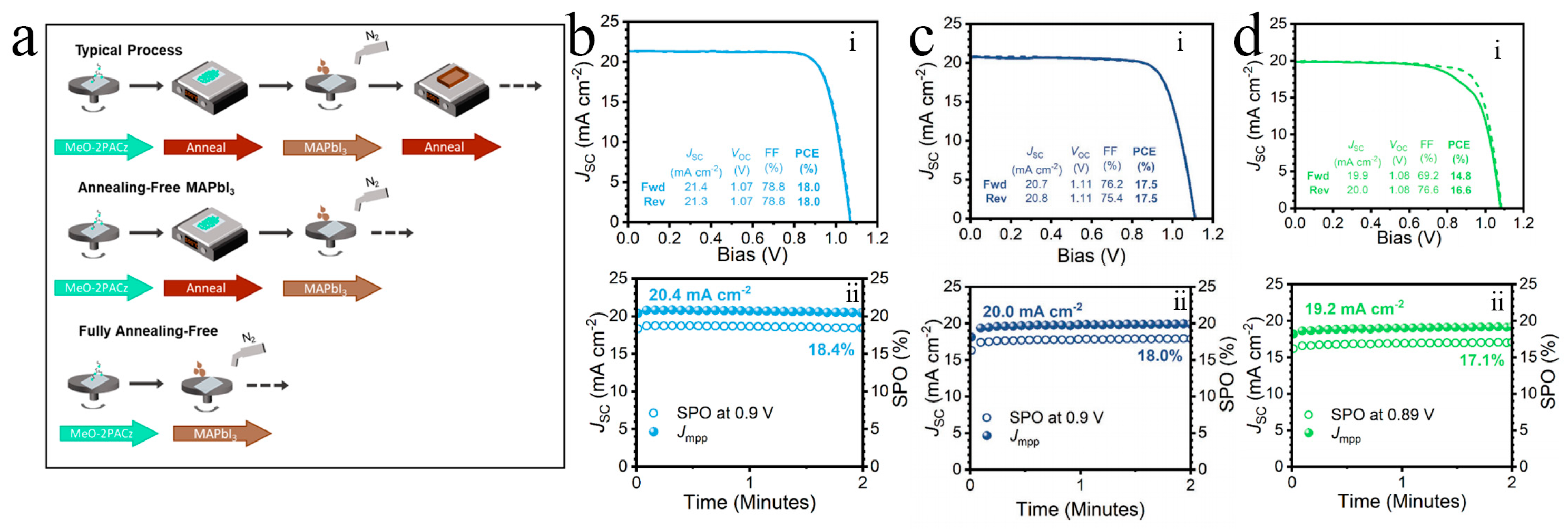
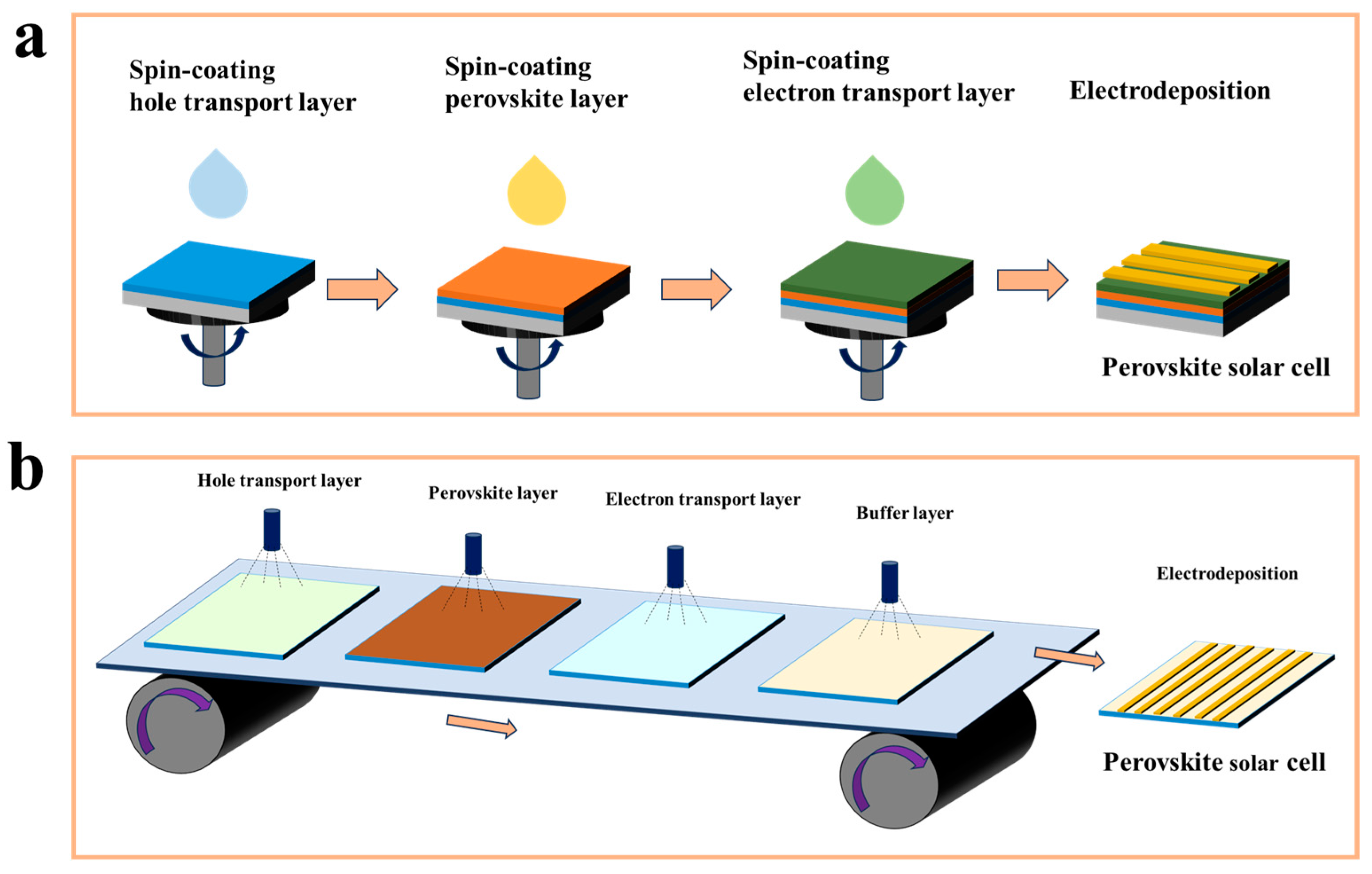
| Device Structure | Solvent | Room-Temperature Process | Performance | References |
|---|---|---|---|---|
| ITO/PEDOT:PSS/MAPbI3/PCBM/Ca/Al | DMF | Doping | 9.32% | [33] |
| ITO/TiO2/MAPbI3/Spiro-OMeTAD/Ag | DMF | Vapor-assisted | 15.6% | [36] |
| FTO/TiO2/MAPbI3/Spiro-OMeTAD/Ag | NMP | Antisolvent immersing | 15.2%. | [37] |
| FTO/c-TiO2/m-TiO2/FA0.5MA0.5PbI3/Spiro-OMeTAD/Ag | DMF | Doping | 17.9% | [32] |
| ITO/PEDOT:PSS/MAPbI3/PCBM/PDPIO/Al | DMF | Vapor-assisted | 16.4% | [38] |
| FTO/c-TiO2/m-TiO2/MAPbI3/Spiro-OMeTAD/Au | DMAc/NMP | Antisolvent rinsing | 17.09% | [39] |
| FTO/c-TiO2/m-TiO2/FA0.8MA0.1Cs0.1PbI3/Spiro-OMeTAD/Ag | DMF/DMSO | Ligand exchange | 18.1% | [40] |
| ITO/NiOx/MAPbI3/C60/Bis-C60/Ag | DMF | Ligand exchange | 17.1% | [41] |
| FTO/c-TiO2/m-TiO2/MAPbI3/Spiro-OMeTAD/MnO3/Ag | TME | Novel solvent | 20.02% | [42] |
| ITO/SnO2/(FAPbI3)1(MAPbBr3)0.05/BABr-PEAI/Spiro-OMeTAD/Ag | DMF/DMSO | Doping | 19.09% | [43] |
| FTO/c-TiOx/m-TiOx/MAPb(I1 − xClx)3/Spiro-OMeTAD/Au | MA/EA/ACN | Novel solvent | 22.32% | [44] |
| ITO/NiOx/MAPb(I1 − xClx)3/PCBM/BCP/Ag | MA/EA/ACN | Novel solvent | 23.07% | [44] |
Disclaimer/Publisher’s Note: The statements, opinions and data contained in all publications are solely those of the individual author(s) and contributor(s) and not of MDPI and/or the editor(s). MDPI and/or the editor(s) disclaim responsibility for any injury to people or property resulting from any ideas, methods, instructions or products referred to in the content. |
© 2023 by the authors. Licensee MDPI, Basel, Switzerland. This article is an open access article distributed under the terms and conditions of the Creative Commons Attribution (CC BY) license (https://creativecommons.org/licenses/by/4.0/).
Share and Cite
Wang, G.; Li, W.; Xu, H.; Song, Q. Low-Cost Room-Temperature Perovskite Solar Cells Suitable for Continuous Production. Electronics 2023, 12, 4498. https://doi.org/10.3390/electronics12214498
Wang G, Li W, Xu H, Song Q. Low-Cost Room-Temperature Perovskite Solar Cells Suitable for Continuous Production. Electronics. 2023; 12(21):4498. https://doi.org/10.3390/electronics12214498
Chicago/Turabian StyleWang, Gang, Weikui Li, Hang Xu, and Qunliang Song. 2023. "Low-Cost Room-Temperature Perovskite Solar Cells Suitable for Continuous Production" Electronics 12, no. 21: 4498. https://doi.org/10.3390/electronics12214498







